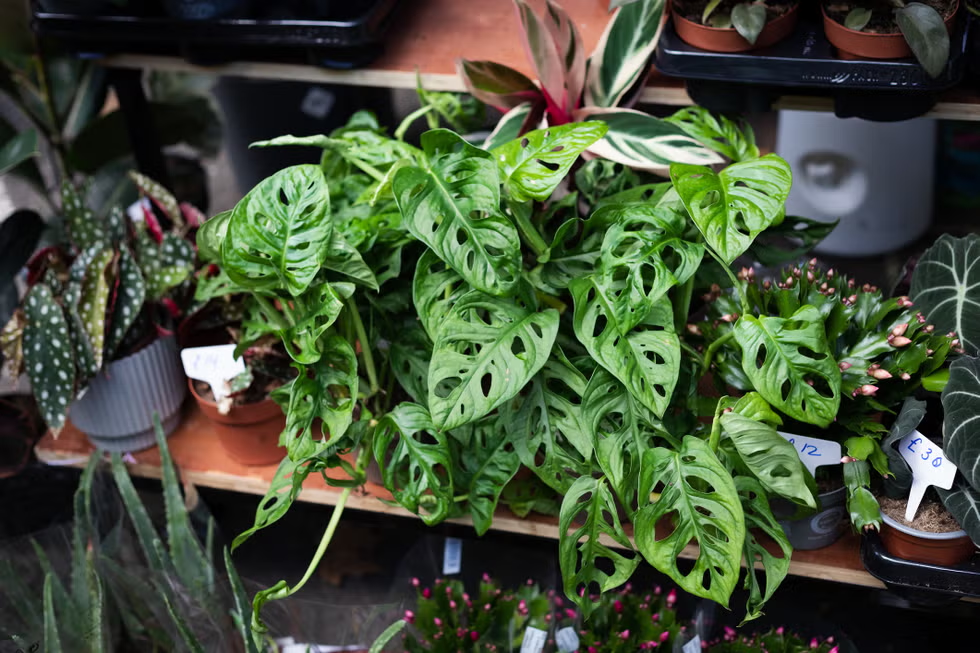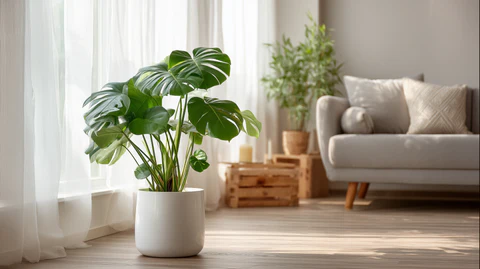The Monstera plant, often called the “Swiss Cheese Plant” because of its iconic split and holey leaves, has become a staple in modern homes. Its lush, tropical vibe and striking foliage instantly elevate any space, making it one of the most popular houseplants around. But while Monstera plants are known for being relatively low-maintenance, they do have specific care needs to thrive indoors.
In this guide, we’ll dive into everything you need to know about how to care for a Monstera plant indoors — from choosing the right spot to watering, feeding, pruning, and dealing with common issues. Whether you’re a first-time plant parent or a seasoned indoor gardener, these tips will help you keep your Monstera happy and healthy.

About the Monstera Plant
The Monstera deliciosa is native to the rainforests of Central America, where it thrives under the forest canopy. In its natural habitat, this climbing evergreen vine uses aerial roots to attach itself to trees and grows up toward the sunlight. Its iconic split leaves are not just beautiful — they help the plant withstand strong winds and heavy rainfall.
Monstera plants can grow quite large indoors, with leaves reaching up to three feet in width if conditions are right. They also occasionally produce edible fruit in their natural habitat, though this is rare indoors.

Choosing the Right Location
Light is one of the most important factors when it comes to caring for a Monstera indoors.
Ideal Lighting Conditions:
- Bright, indirect light is best. A spot near an east-facing window or a few feet away from a bright south or west-facing window works wonderfully.
- Direct sunlight can scorch the leaves, while too little light may cause slow growth and small, unsplit leaves.
Signs of Improper Lighting:
- Too much light: Brown, crispy edges on the leaves.
- Too little light: Pale leaves, leggy growth, or no new leaf splits.
Pro tip: If your home lacks natural light, Monsteras adapt well to grow lights — choose a full-spectrum LED grow light to mimic natural sunlight.

Watering Your Monstera
Monsteras prefer consistently moist (but never soggy) soil. Overwatering is one of the most common mistakes new plant owners make.
Watering Guidelines:
- Water your Monstera when the top 2–3 inches of soil feel dry.
- Use room-temperature, filtered water if possible.
- Make sure the pot has drainage holes to prevent root rot.
How Often to Water:
- Typically, water every 1–2 weeks, adjusting based on the season and your home’s humidity.
Signs of Overwatering:
- Yellowing leaves
- Mushy stems
- Foul-smelling soil
Signs of Underwatering:
- Drooping leaves
- Crispy brown edges
- Slow or stunted growth

Humidity and Temperature Needs
Since Monstera plants are native to tropical rainforests, they love warm, humid conditions.
Ideal Temperature:
- Between 65°F and 85°F (18°C to 29°C).
- Avoid exposing your Monstera to cold drafts or sudden temperature changes.
Humidity Requirements:
- Prefers humidity levels of 60% or higher.
- Mist the leaves regularly, place a humidifier nearby, or use a pebble tray with water to boost local humidity.
Leaf tip browning can be a sign of low humidity, especially during winter when indoor air tends to be drier.
Choosing the Right Soil and Pot
A well-draining, aerated potting mix is essential for keeping your Monstera’s roots healthy.
Best Soil Mix:
- A mixture of peat-based potting soil, orchid bark, and perlite or pumice works beautifully.
- The soil should hold some moisture but allow excess water to drain away easily.
Pot Selection:
- Choose a pot with drainage holes.
- Terracotta pots help wick away excess moisture, while plastic pots retain more water.
Repotting Tips:
- Repot every 1–2 years or when roots start growing out of the drainage holes.
- Spring or early summer is the best time to repot.
Fertilizing Your Monstera
To encourage lush, vigorous growth, Monsteras benefit from regular feeding during the growing season.
Fertilizing Schedule:
- Feed every 4–6 weeks from spring through early fall.
- Use a balanced, water-soluble houseplant fertilizer diluted to half strength.
Avoid fertilizing in winter, as the plant’s growth naturally slows down during this period.
Signs Your Plant Needs Fertilizer:
- Pale leaves
- Slow growth
- Smaller new leaves without splits
Pruning and Training
Monsteras are natural climbers, and with the right support, they can grow tall and sprawling indoors.
Pruning Tips:
- Regularly remove yellow, damaged, or old leaves.
- Prune leggy stems to encourage bushier growth.
- Always use clean, sharp scissors or pruning shears.
Training Your Monstera:
- Use a moss pole or trellis to support vertical growth.
- Secure the stems with soft plant ties or twine.
Bonus Tip: Wipe the leaves occasionally with a damp cloth to remove dust and keep them shiny.
Propagating a Monstera
One of the joys of owning a Monstera is how easy it is to propagate and share with friends.
Propagation by Stem Cutting:
- Choose a healthy stem with at least one node (a bump where a leaf and aerial root emerge).
- Cut just below the node.
- Place the cutting in water or moist soil.
- Keep in a warm, bright location.
- Roots should develop within 2–4 weeks.
Once roots are a few inches long, you can transplant the cutting into a pot with soil.
Common Monstera Problems (and How to Fix Them)
1. Yellowing Leaves:
Usually a sign of overwatering. Check soil moisture and drainage.
2. Brown, Crispy Edges:
Often caused by low humidity or underwatering. Increase humidity and check watering frequency.
3. Small, Unsplitted Leaves:
Likely due to insufficient light. Move to a brighter location or add a grow light.
4. Drooping Leaves:
Could mean either underwatering or overwatering. Check soil moisture before watering.
Final Thoughts
Caring for a Monstera indoors is a rewarding and relatively easy experience, making it a perfect addition to any home — whether you’re a beginner plant parent or an experienced plant lover. By providing the right balance of light, water, humidity, and nutrients, your Monstera will thrive and grace your space with its stunning, sculptural leaves for years to come.
If you’ve been dreaming of creating a lush indoor jungle, starting with a Monstera is a great first step!





Leave A Comment